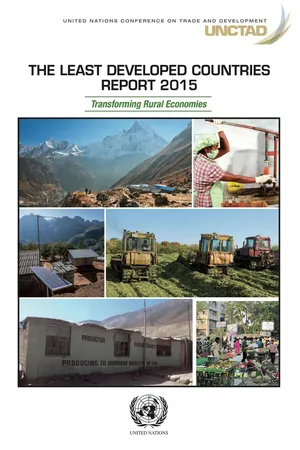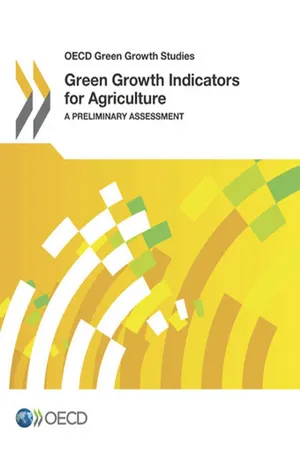Geography
Agriculture Productivity
Agricultural productivity refers to the efficiency of agricultural production, typically measured by the amount of output produced per unit of input, such as land, labor, or capital. It is a key factor in determining the overall economic performance and food security of a region or country. Factors influencing agricultural productivity include technology, infrastructure, climate, and government policies.
Written by Perlego with AI-assistance
Related key terms
1 of 5
3 Key excerpts on "Agriculture Productivity"
- No longer available |Learn more
The Least Developed Countries Report 2015
Transforming Rural Economies
- United Nations Conference on Trade and Development (UNCTAD)(Author)
- 2015(Publication Date)
- United Nations Publications(Publisher)
This explains to some extent why the partial indicators of productivity are much higher in Asian LDCs than in other LDCs. At the same time, it points to an area for policy action to help reverse the low productivity in African LDCs. A survey was conducted with more than 100 agriculture experts working in Africa, asking them to identify the most important factors in advancing agriculture on the continent. Some 21 per cent of respondents identified such activities as enhancement of soil fertility, improved water management techniques and policy reform as the primary drivers of African agriculture, which were especially successful in southern Africa (Gabre-Madin and Haggblade, 2004). 2. T ECHNOLOGY , INPUT QUALITY AND HUMAN CAPITAL Technology plays a crucial role in determining agricultural productivity, as evidenced for instance by its effects on crop variety yields. The fact that the bulk of productivity enhancements achieved in LDCs have come from increased yields (rather than from labour productivity) points to the importance of technology embodied in higher-yielding varieties or in superior species of cattle, which can improve the well-being of farmers. Technology directly influences not only variety yields, but also the adaptation of plant and animal varieties to local agroecological conditions, the quality of inputs (seeds, fertilizers, machinery), the choice of cultivation and rearing techniques, etc. Producers’ capacity to learn and adapt to new technologies and circumstances is partly determined by the quality of their human capital. a. Technology and input quality Agricultural innovations derive largely from agricultural research and development (R&D), which expands the set of technologies available to farmers. - Singh, M P, Soma Dey(Authors)
- 2021(Publication Date)
- Daya Publishing House(Publisher)
Despite heavy investments in both machinery and land-saving inputs, farmers in these countries still face the unpleasant reality of a land and labour productivity that do not match the minimum outputs imposed by their demographic and socio-economic pressure. The need for high labour productivity (socio-economic pressure) and eventually land productivity (demographic pressure) at the level of society, reflected into changes in technical coefficients at the farm level, is intricately linked to changes occurring in the energy budget of socio-economic systems to which the agricultural system belongs. Economic development, assessed at the socio-economic level, inevitably results in a continuously increasing opportunity cost of human labour and capital at the farm level, and pushes This ebook is exclusively for this university only. Cannot be resold/distributed. technical development of the farming system towards mechanization, specialization, economies of scale, lineraization of nutrient inputs in the agroecosystem, and dependence on price support and other subsidies. This chain of changes, well-known in the field of agricultural economics though generally described from a different perspective, is the main cause of the abandonment of traditional farming strategies, and the consequent loss of biodiversity in agriculture. Most notably, two important trends follow from this process of technological change : adoption of monocultures, and reduced use of by-products, such as crop residues and manure, in the agricultural process. Natural ecosystems (e.g. mature natural forest) are able to sustain a large amount of biomass, but with a net primary productivity that is relatively low compared to agroecosystems. Traditional farming systems based on gardening in natural forests can produce large quantities of biomass per hectare on the cleared areas, but only with a long cycle of rotation.- eBook - PDF
- OECD(Author)
- 2014(Publication Date)
- OECD(Publisher)
3. MONITORING THE ENVIRONMENTAL EFFICIENCY AND NATURAL RESOURCE PRODUCTIVITY OF AGRICULTURE – 41 GREEN GROWTH INDICATORS FOR AGRICULTURE: A PRELIMINARY ASSESSMENT © OECD 2014 Carbon productivity Policy context Agricultural production not only uses environmental resources as inputs, it also places pressure on the environment by emitting pollutants such as GHGs, therefore contributing to climate change. Agriculture is highly exposed to climate change, which may have an impact on yields, location of production and costs of production and thus with potential risks for food supply, food prices and farm incomes. The relationship between agriculture and climate change is complex. Agriculture not only contributes to GHGs, but it also provides a carbon sink function under certain management practices. Moreover, agriculture is subject to the impact of climate change. While farming is a source of GHGs, principally methane (CH 4 ) and nitrous oxide (N 2 O), which are part of the primary driving force behind climate change, climate change may also impact on farm production. Although there are no specific agricultural commitments under the United Nations Framework Convention on Climate Change (UNFCCC) to reduce GHG emissions, many OECD countries are developing agricultural climate change programmes aimed at reducing GHGs, promoting carbon sinks, and making agriculture more resilient to the impact of climate change. A key challenge in relation to agriculture and agricultural GHG emissions is to reduce the overall level and rate of emission release per unit volume of agricultural production. Monitoring progress The progress of green growth in agriculture can be assessed against trends in agricultural GHG emissions and the level of decoupling achieved between GHGs and economic growth in agriculture. The proposed indicator relates to the carbon productivity of agriculture defined as the amount of agricultural GDP per unit of carbon equivalents emitted by agriculture.
Index pages curate the most relevant extracts from our library of academic textbooks. They’ve been created using an in-house natural language model (NLM), each adding context and meaning to key research topics.


